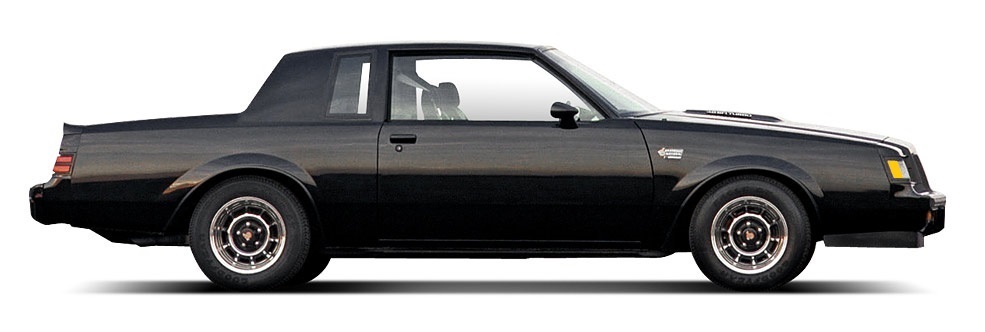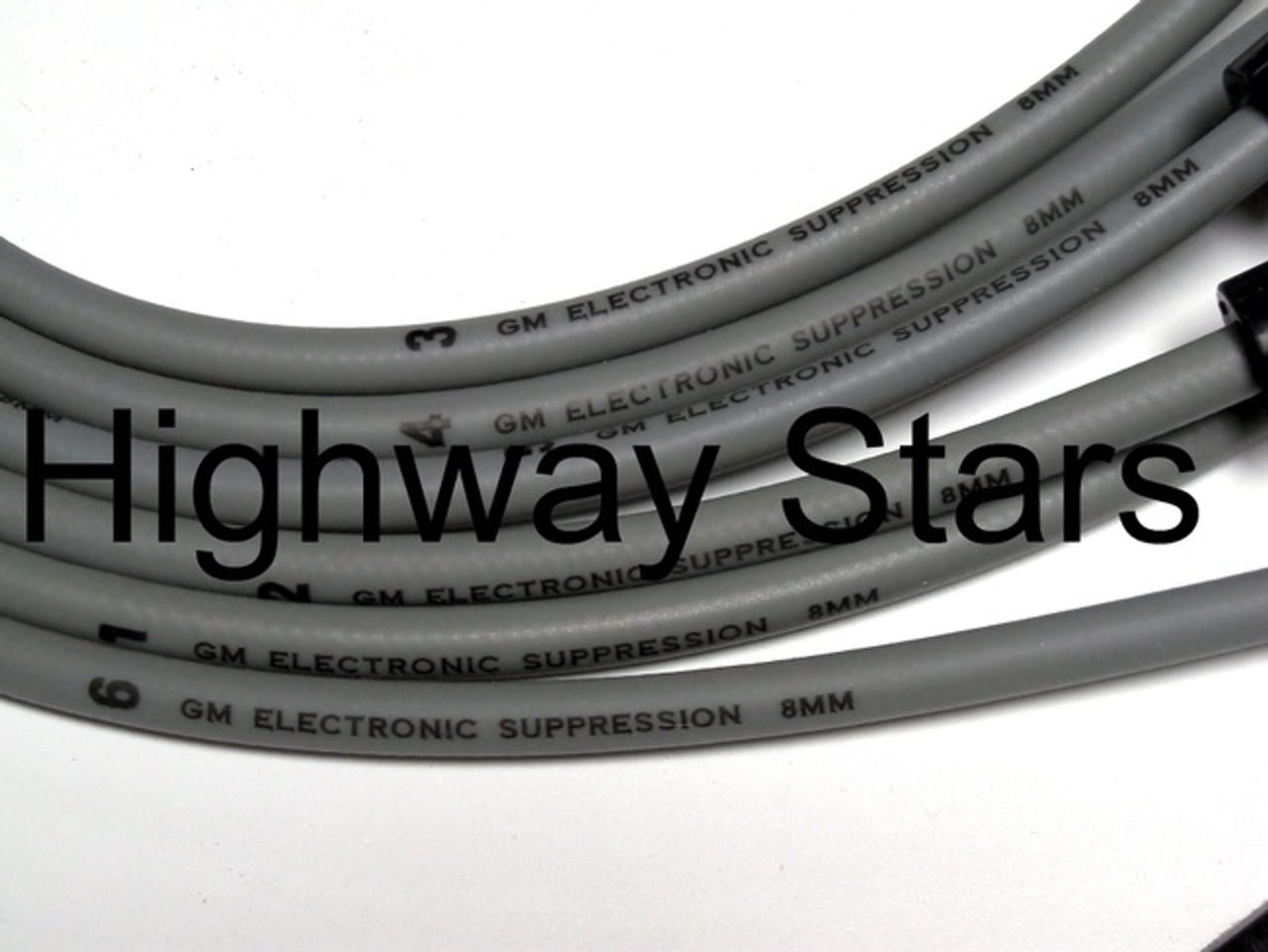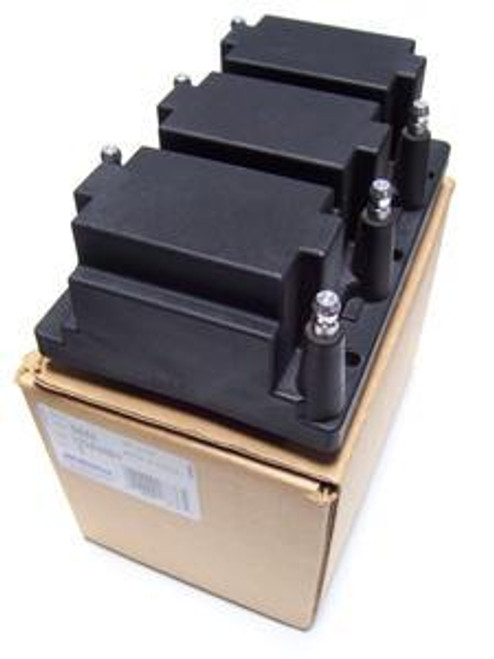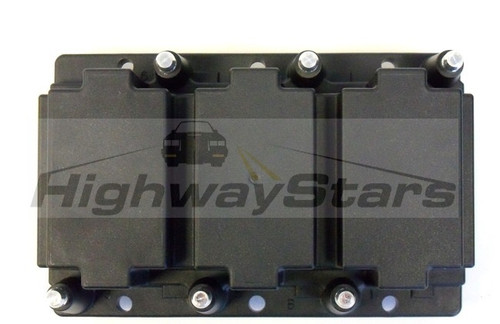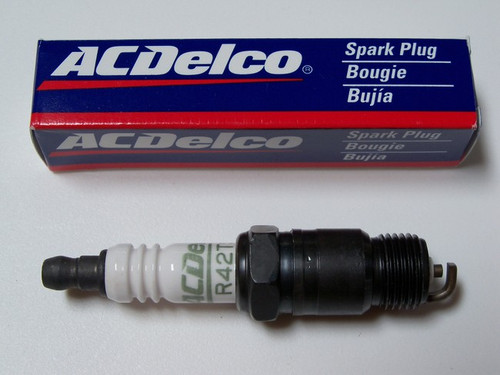Product Description
GM Licensed Restoration Spark Plug Ignition Wires
This GM Licensed product has been viewed, inspected and approved by General Motors (GM) as a "Highway Stars GM Licensed product. GM reviews all of our licensed products for material quality, authenticity, and accuracy. You will not find this Highway Stars-GM Licensed product sold anywhere else.
For Vin 7 1986-1987 Buick Grand National, Turbo Regal, and 1987 GNX
NOW AVAILABLE through HIGHWAY STARS
Absolutely Perfect for your GNX, Grand National, Turbo Regal
Another Great GM Licensed Restoration product brought to you by Highway Stars
Looks like factory original:
- Numbered GM supression wires - same as original
- Boots - same as original
- Wire color - same as original
- Length - same as original
- 8mm diameter - same as original
- Section of convoluted tubing on Wire # 6 - same as original
Upgraded & Improved Performance: The best of both worlds for "Stock" OR "Modified" Vehicles
- 8 mm Super Mag Wires insulate up to 50,000 volts - Most street and modified production engines don't need a cable size larger than 8.mm. Using a 10mm size cable is usually overkill (or strictly for appearance).
- 600+ degree temperature resistant pure silicone jacketed wire
- 600+ degree temperature resistant pure silicone boots
- 100% Stainless Steel plug terminals
- 100% Stainless Steel coil terminals
- Kevlar stranded inner core for maximum strength
- Fiberglass braided sheath for additional strength & flexibility
- Stainless steel spiral core conductor for lowest impedance with maximum EMI & RFI supression
- 100,000+ mile design life
Additional Benefits:
- Properly terminated plug wires-Assembled using professional industrial equipment specific for this application which ensures enough & consistent compression that can not be matched when using hand crimpers for homemade wire sets
- No voltage leakage/No scored boots - Assembled using professional industrial equipment specific for this application, therefore the inside of the boot does not get scored and thus there is NO voltage leakage, (scored boots/voltage leakage is commonly associated with Unbranded DIY assembled sets).
- Exceeded the Highest & Most Stringent Quality Standards of ALL Ignition Wire manufacturers
- Tested & Exceeded SAE Standard for voltage leakage when immersed in HOT OIL
- Tested & Exceeded SAE Standard for voltage leakage when immersed in SALT WATER
- Tested & Exceeded SAE Standard for voltage leakage when immersed in GASOLINE
- Tested & Exceeded SAE Standard for voltage leakage when immersed in HOT COOLANT
- Plug boots permanently affixed to wires in order to prevent terminal slippage during install
- Wires fit in the factory original keepers
- Includes a FREE tube of Dielectric grease for proper installation
- Includes a diagram for factory original installation
- Another GM Licensed Restoration Product brought to you by HIGHWAY STARS
- Wire manufactured & assembled in the USA
Every brand of spiral conductor ignition wires will perform the function of conducting coil output to the spark plugs, but NONE, despite the claims made in advertisements and other promotional literature, will increase horsepower. Independent tests, including a test performed by Circle Track Magazine (see May, 1996 issue) in the USA, show that NO "low-resistance" ignition wires for which a horsepower increase is claimed do in fact increase horsepower
"LOW-RESISTANCE" SPIRAL WIRES
By far the most popular conductor used in ignition wires destined for race and performance street engines are spiral conductors (a.k.a. mag, pro, super, spiral, monel, heli, energy, ferro, twin core etc.). Spiral conductors are constructed by winding fine wire around a core. Almost all manufacturers use constructions which reduce production costs in an endeavor to offer ignition component marketers and mass-merchandisers cheaper prices than those of their competitors.
In the USA in particular, most marketers of performance parts selling their products through mass-merchandisers and speed shops include a variety of very effective high-output ignition systems together with a branded not-so-effective ignition wire line using a spiral conductor. Most perpetually try to out-do their competitors by offering spiral conductor ignition wires with the lowest electrical resistance. Some publish results which show their wires are superior to a competitor's wires which use identical cable (on which another brand name is printed). The published "low" resistance (per foot) is measured with a test ohmmeter's 1 volt direct current (DC) passing through the entire length of the fine wire used for the spiral conductor.
"Low-resistance" conductors are an easy sell, as most people associate all ignition wire conductors with original equipment and replacement ignition wire carbon conductors (which progressively fail as a result of microscopic carbon granules burning away and thus reducing the spark energy to the spark plugs) and with solid wire zero-resistance conductors that were used by racers with no need for suppression. Consumers are easily led into believing that if a spiral conductor's resistance is almost zero, its performance must be similar to that of a solid metal conductor all race cars once used. HOWEVER, NOTHING IS FURTHER FROM THE TRUTH!
What is not generally understood (or is ignored) is that as a result of the laws of electricity, the potential 45,000 plus volts (with alternating current characteristics) from the ignition coil (a pulse type transformer) does not flow through the entire the length of fine wire used for a spiral conductor like the 1 volt DC voltage from a test ohmmeter, but flows in a magnetic field surrounding the outermost surface of the spiral windings (skin effect). The same skin effect applies equally to the same pulsating flow of current passing through carbon and solid metal conductors.
A spiral conductor with a low electrical resistance measured by an ohmmeter indicates, in reality, nothing other than less of the expensive fine wire is used for the conductor windings a construction which cannot achieve a clean and efficient current flow through the magnetic field surrounding the windings, resulting in poor suppression for RFI and EMI.
Of course, ignition wire manufacturers save a considerable amount in manufacturing costs by using less fine wire, less exotic winding machinery and less expertise to make low-resistance spiral conductors. As an incentive, they find a lucrative market amongst performance parts marketers who advertise their branded ignition wires as having "low-resistance" conductors, despite the fact that such "low-resistance" contributes nothing to make spiral ignition wires perform better, and RFI and EMI suppression is compromised.
In recent years, most ignition wire manufacturers, to temporarily improve their spiral conductor's suppression, have resorted to coating excessively spaced spiral windings, most of which are crudely wound around strands of fiberglass or Kevlar, with a heavy layer of high-resistance carbon impregnated conductive latex or silicone compound. This type of construction hides the conductive coating's high resistance when the overall conductor is measured with a test ohmmeter, which only measures the lower resistance of the sparse spirally wound wire (the path of least resistance) under the conductive coating and ignores the high resistance of the outermost conductive coating in which the spark energy actually travels. The conductive coating is rarely shown or mentioned in advertisement illustrations.
The suppression achieved by this practice of coating the windings is only temporary, as the spark current is forced to travel through the outermost high-resistance conductive coating in the same manner the spark current travels through the outermost high-resistance conductive coating of a carbon conductor used in most original equipment and stock replacement wires.
In effect, (when new) a coated "low-resistance" spiral conductor's true performance is identical to that of a high-resistance carbon conductor.
Unfortunately, and particularly with the use of high-output ignitions, the outermost high-resistance conductive coating over spiral windings acting as the conductor will fail from burn out in the same manner as carbon conductors, and although in most cases, the spiral conductor will not cease to conduct like a high-resistance carbon conductor, any RFI or EMI suppression will be lost as a consequence of the coating burning out. The worst interference will come from the so-called "super conductors" that are wound with copper (alloy) wire.
However, despite the shortcomings of "low-resistance" spiral conductor ignition wires, these wires work satisfactorily on older production vehicles and race vehicles that do not rely on electronic engine management systems, or use on-board electronics effected by EMI although with the lowest-resistance conductor wires, don't expect much RFI suppression on the AM band in poor reception areas.
Some European and Japanese original equipment and replacement ignition wires including Bougicord and NGK do have spiral conductors that provide good suppression usually none of these wires are promoted as having low- resistance conductors however, none are ideal for competition use, as their conductors and pin-type terminations are fragile and are known to rarely last as long as good carbon conductor ignition wires.
To be effective in carrying the full output from the ignition system and suppressing RFI and EMI in particular, spiral conductors need windings that are microscopically close to one another and precisely spaced and free from conductive coatings. To be more effective, the windings need to be wound over a core of magnetic material a method too costly for wires sold through mass-merchandisers and most speed shops who purchase only the cheapest (to them) and most heavily promoted products.
Product Videos
Custom Field
Product Reviews
14 Reviews Hide Reviews Show Reviews
-
Quality parts
The wires were very nice , as with all of the parts that I have received from high way-stars . You order it and you know that you’re not going to be disappointed
-
Best wires!
They were exact replicas! Highway Stars has the best products!
-
Great product!
I purchased these to replace a set of aftermarket wires on my 1987 GN. They look great, and go well with my otherwise all original car.
-
New GM licensed spark plug wires.
Excellent factory look. I put these on a 30000 mile unrestored car. Some people thought they were the originals. Perfect length also. Engine runs well with no skips either. Perfect addition to a restoration or a 100 point showcar .
-
Excellent Fit
I bought these wires to replace a set that was similar and it was immediately clear how much nicer these reproduction wires are. The length is great and they look very clean in the factory wire clips. (A small tube of dielectric grease is included)

